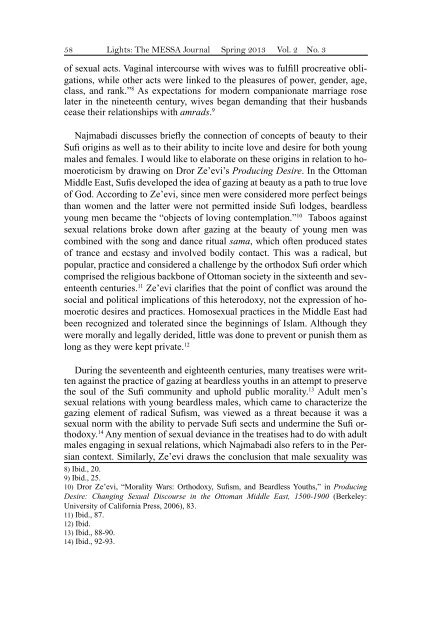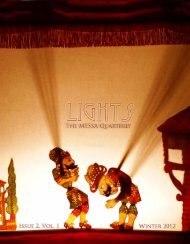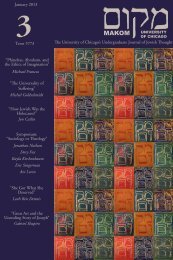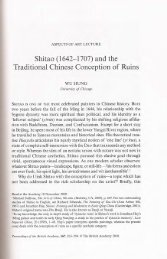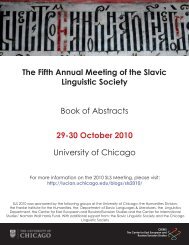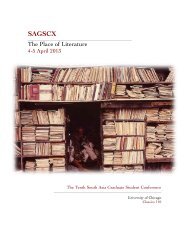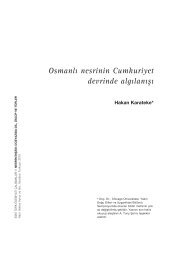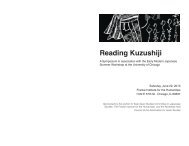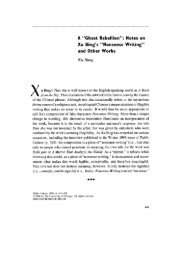Create successful ePaper yourself
Turn your PDF publications into a flip-book with our unique Google optimized e-Paper software.
58 Lights: The MESSA Journal Spring 2013 Vol. 2 No. 3<br />
<strong>of</strong> sexual acts. Vaginal intercourse with wives was to fulfill procreative obligations,<br />
while other acts were linked to the pleasures <strong>of</strong> power, gender, age,<br />
class, and rank.” 8 As expectations for modern companionate marriage rose<br />
later in the nineteenth century, wives began demanding that their husbands<br />
cease their relationships with amrads. 9<br />
Najmabadi discusses briefly the connection <strong>of</strong> concepts <strong>of</strong> beauty to their<br />
Sufi origins as well as to their ability to incite love and desire for both young<br />
males and females. I would like to elaborate on these origins in relation to homoeroticism<br />
by drawing on Dror Ze’evi’s Producing Desire. In the Ottoman<br />
Middle East, Sufis developed the idea <strong>of</strong> gazing at beauty as a path to true love<br />
<strong>of</strong> God. According to Ze’evi, since men were considered more perfect beings<br />
than women and the latter were not permitted inside Sufi lodges, beardless<br />
young men became the “objects <strong>of</strong> loving contemplation.” 10 Taboos against<br />
sexual relations broke down after gazing at the beauty <strong>of</strong> young men was<br />
combined with the song and dance ritual sama, which <strong>of</strong>ten produced states<br />
<strong>of</strong> trance and ecstasy and involved bodily contact. This was a radical, but<br />
popular, practice and considered a challenge by the orthodox Sufi order which<br />
comprised the religious backbone <strong>of</strong> Ottoman society in the sixteenth and seventeenth<br />
centuries. 11 Ze’evi clarifies that the point <strong>of</strong> conflict was around the<br />
social and political implications <strong>of</strong> this heterodoxy, not the expression <strong>of</strong> homoerotic<br />
desires and practices. Homosexual practices in the Middle East had<br />
been recognized and tolerated since the beginnings <strong>of</strong> Islam. Although they<br />
were morally and legally derided, little was done to prevent or punish them as<br />
long as they were kept private. 12<br />
During the seventeenth and eighteenth centuries, many treatises were written<br />
against the practice <strong>of</strong> gazing at beardless youths in an attempt to preserve<br />
the soul <strong>of</strong> the Sufi community and uphold public morality. 13 Adult men’s<br />
sexual relations with young beardless males, which came to characterize the<br />
gazing element <strong>of</strong> radical Sufism, was viewed as a threat because it was a<br />
sexual norm with the ability to pervade Sufi sects and undermine the Sufi orthodoxy.<br />
14 Any mention <strong>of</strong> sexual deviance in the treatises had to do with adult<br />
males engaging in sexual relations, which Najmabadi also refers to in the Persian<br />
context. Similarly, Ze’evi draws the conclusion that male sexuality was<br />
8) Ibid., 20.<br />
9) Ibid., 25.<br />
10) Dror Ze’evi, “Morality Wars: Orthodoxy, Sufism, and Beardless Youths,” in Producing<br />
Desire: Changing Sexual Discourse in the Ottoman Middle East, 1500-1900 (Berkeley:<br />
<strong>University</strong> <strong>of</strong> California Press, 2006), 83.<br />
11) Ibid., 87.<br />
12) Ibid.<br />
13) Ibid., 88-90.<br />
14) Ibid., 92-93.


